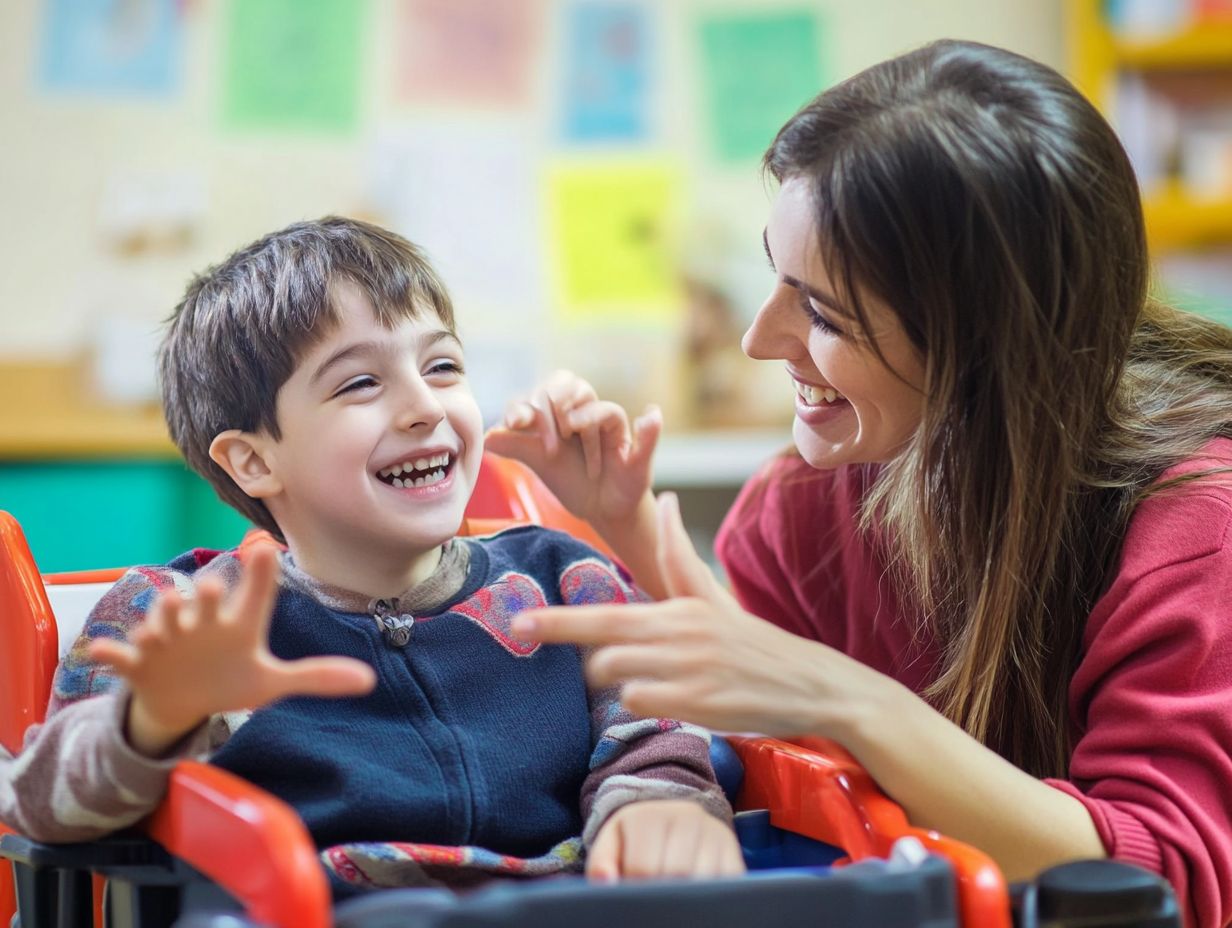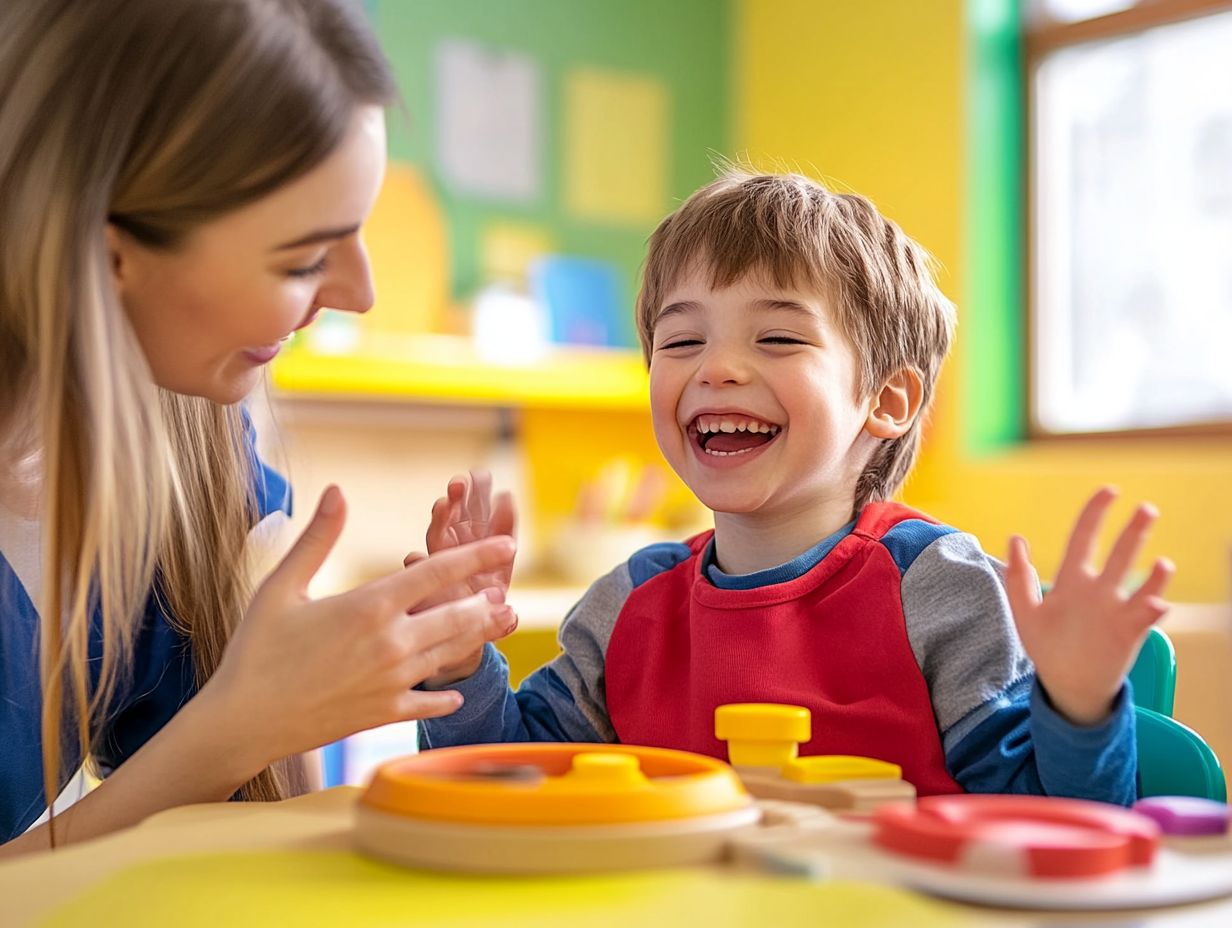Communicating Effectively with Special Needs Kids
Contents
- Communicating Effectively with Special Needs Kids
- How to Build a Strong Relationship with Special Needs Kids, especially those with Developmental Disabilities?
- Frequently Asked Questions
- Connecting Better with Special Needs Children
- What are some common challenges when communicating with special needs kids and patients?
- How can I best communicate with a child with special needs, including those with autism?
- What are some strategies for promoting effective communication with special needs kids, caregivers, and families?
- What should I do if I am having trouble understanding a child’s communication or nonverbal communication?
- How can I help a child with special needs improve their communication skills and language skills?
- What are some resources and supports available for improving communication with special needs kids and their families?
Communicating Effectively with Special Needs Kids
Effective communication with children who have special needs demands a thoughtful approach that honors their unique modes of expression and addresses their developmental differences.
This article delves into a range of strategies designed to help you connect with these remarkable kids. You ll discover the importance of understanding their communication styles, utilizing visual aids like picture cards, and applying positive reinforcement.
The article also highlights techniques for nurturing strong relationships, including the power of empathy, the significance of celebrating their achievements, and the use of concrete language.
By embracing these methods, you can cultivate meaningful interactions that empower and support special needs children in their everyday lives, fostering a deeper connection and understanding.
Key Takeaways

- Understanding a special needs child’s communication style is crucial for effective communication and emotional support.
- Using visual aids, such as picture cards and choice boards, and assistive devices can enhance understanding for special needs children.
- Positive reinforcement can help motivate and encourage special needs children to communicate effectively and improve their emotional expression.
How to Communicate with Special Needs Kids?
Communicating with children with special needs necessitates a thoughtful approach that honors their distinctive communication styles and challenges. As a caregiver or instructor, it is crucial for you to be aware of various communication strategies that can help with communication and foster connection and understanding.
By focusing on effective communication, these strategies can bridge the gap between assumptions and the child’s emotional expressions, paving the way for better social interactions and a more profound relationship. Each child with special needs may display unique behaviors and communication preferences shaped by their disabilities, making it essential for you to adapt your methods accordingly, perhaps by using storytelling or providing choices to meet their needs.
1. Understanding Their Communication Styles
Understanding the communication styles of children with special needs is essential for effective interaction and support. Each child may have their unique way of expressing themselves, often relying on nonverbal cues such as gestures, facial expressions, or eye contact to convey their thoughts and feelings.
Some children might prefer using concrete language, favoring straightforward and simple phrases while steering clear of abstract concepts. This diversity in communication styles underscores the importance of being adaptable and observant as a caregiver or instructor.
By tuning into the individual needs of each child, you can adjust your strategies perhaps by incorporating visual aids like visual schedules or engaging in parallel play to enhance understanding. This personalized approach makes communication easier and creates a nurturing environment where every child feels valued and understood.
2. Using Visual Aids and Assistive Devices
Utilizing visual aids and assistive devices can profoundly enhance communication for children with special needs, offering them tangible tools for expression and overcoming environmental barriers.
These instruments, including picture cards and choice boards, act as powerful bridges between verbal and non-verbal communication. Picture cards can illustrate common needs, emotions, or activities, allowing children to convey their thoughts when words might escape them. For example, a child equipped with picture cards can effortlessly indicate hunger or the desire to play by simply pointing to the appropriate card, promoting functional communication.
In a similar vein, choice boards provide a structured method for children to make decisions, fostering a sense of independence. By incorporating these visual aids into daily routines, such as mealtime or playtime, you can enhance engagement and enable decision-making, leading to more meaningful interactions.
3. Using Positive Reinforcement
Positive reinforcement stands as a cornerstone in your communication with children with disabilities, effectively encouraging desired behaviors while helping them feel safe and understood.
By employing techniques such as verbal praise or tangible rewards, or even a simple high-five, you can inspire these children. For example, when a child successfully uses a new word or phrase, providing immediate praise can reinforce that achievement. This nurtures both their communication skills and self-esteem.
Incorporating visual aids or reward charts can engage these learners even further, offering them clear goals to work toward. Over time, these positive experiences will play a vital role in building their overall confidence. This enables them to interact more freely and openly with their peers and expands their vocabulary and language skills.
4. Being Patient and Supportive

Being patient and supportive is essential when you communicate with children with disabilities. This approach cultivates a trusting environment where they feel safe to express themselves fully and helps in processing the time required for their responses.
When children trust you, they are more likely to open up, leading to deeper, more meaningful conversations. You can promote effective communication by employing strategies like active listening this involves giving your full attention to what the child is saying without interruptions.
Tailoring your communication style to meet each child s unique needs, such as using visual aids, sign language (a way of communicating using hand gestures), or simplified speech, can significantly enhance the interaction and provide emotional support.
Creating a calm and distraction-free environment is crucial; it helps reduce anxiety and increases the chances that a child will engage with you. When patience and understanding lead the way, children are excited to share their thoughts, resulting in improved social skills, greater self-confidence, and better overall engagement.
What Are Some Effective Communication Strategies?
Implementing effective communication strategies is crucial for engaging with children with disabilities. By doing so, you ensure their needs are not only met but also understood by caregivers and instructors. This fosters an environment of support and understanding, especially for those with autism and developmental disabilities.
1. Using Simple and Clear Language
Using simple and clear language is a foundational strategy for effective communication with children with disabilities. This approach not only aids comprehension but also fosters a sense of security and confidence in young learners, helping them to build strong, supportive relationships.
As a caregiver or instructor, utilize specific phrases that are both direct and relatable. For instance, instead of using complex terms, try replacing them with concrete examples. Rather than saying “sensation,” consider saying, “how it feels when you touch something soft like a pillow.” This helps to find a middle ground in communication.
Incorporating visual aids alongside verbal communication can significantly enhance clarity. When discussing colors, for example, showing the actual object or a picture can help bridge understanding. This ensures that your message is conveyed effectively and contributes to creating a supportive learning environment.
How to Build a Strong Relationship with Special Needs Kids, especially those with Developmental Disabilities?
2. Using Nonverbal Communication
Nonverbal communication, including gestures and facial expressions, plays a crucial role in how children with special needs express themselves and understand those around them. This form of interaction often serves as a bridge where verbal skills may be limited, allowing these children to convey their feelings, intentions, and reactions more effectively, especially when addressing developmental challenges.
For instance, a simple thumbs up can signify approval or enjoyment, while a frown may indicate discomfort or displeasure. Incorporating visual supports, such as pictures or symbols, can further enhance their ability to communicate their needs and preferences, effectively breaking down environmental barriers.
Utilizing techniques like modeling specific gestures or engaging in expressive play can enrich these children’s emotional vocabulary. This enables them to navigate social situations with greater ease, which is particularly beneficial for those with developmental disabilities.
By recognizing and understanding these nonverbal cues, you can significantly enhance interactions between special needs children and their peers, caregivers, and educators. This fosters better social interactions and overall communication skills.
3. Encouraging Active Listening
Encouraging active listening is a compelling communication strategy that fosters engagement and enhances social interactions with children who have special needs. By creating a space where kids feel listened to and understood, you can significantly improve their capacity to express themselves and interact with others, addressing their developmental differences and needs.
Active listening requires your full attention, validating their feelings, and responding appropriately. This approach sharpens their communication skills and builds trust. Simple strategies, such as maintaining eye contact, employing open body language, and reflecting back what has been communicated, can effectively model this behavior and improve their engagement.
In embracing these techniques, you enable these children to engage more meaningfully in conversations. This fosters their confidence, enriches their social skills, and provides the necessary attention they deserve.
4. Adjusting to Individual Needs

Adjusting your communication strategies to cater to the individual needs of children with special needs is vital for fostering effective relationships and understanding, especially for those with developmental disabilities and sensory processing issues.
This tailored approach not only enhances clarity in your interactions but also honors each child s unique way of processing information. For instance, you may find that some children respond more positively to visual cues, such as picture schedules or gesture-based communication, helping them express themselves better. Others might thrive on a more structured routine or consistent verbal prompts that provide security and help them grasp expectations. This helps in better understanding and accommodating their developmental challenges.
By recognizing these diverse communication styles, you can create inclusive environments where every child feels valued and enabled to engage meaningfully with others. This is crucial in establishing effective communication and strong relationships with children with special needs.
Building a strong relationship with special needs children is a rewarding journey that requires your consistent effort, deep empathy, and effective communication skills, which are essential for their overall development and emotional support. Effective communication often involves using concrete language and being mindful of environmental barriers.
By fostering a secure environment, you create a foundation for emotional support and development that truly enables them. This approach also helps in addressing behaviors and improving their social interactions.
1. Show Empathy and Understanding
Demonstrating empathy and understanding towards children with special needs is essential for building trust and rapport in communication. When you approach these children with patience and attentiveness, you cultivate an environment where they feel safe and valued.
This can be particularly beneficial for children with autism and other developmental disabilities. For instance, using active listening skills like maintaining eye contact and nodding to acknowledge their feelings can convey genuine concern for their emotions.
When a child expresses frustration, acknowledging their feelings with statements such as, “I can see that you’re feeling upset, and that’s okay,” can deepen your connection with them. This also helps improve their functional communication and emotional expression.
Adapting your communication methods, whether through visual aids or simplified language, reflects your commitment to understanding and addressing each child’s unique needs, further strengthening this vital bond. Utilizing tools like picture cards and choice boards can also be highly effective communication strategies.
2. Celebrate Their Achievements and Encourage Vocabulary Expansion
Celebrating the achievements of special needs children, regardless of their size, is vital for providing positive reinforcement and encouraging ongoing progress. This practice can also aid in vocabulary expansion and language skills development.
This recognition plays a crucial role in their development, significantly boosting their self-esteem and fostering a sense of belonging. When you acknowledge accomplishments whether monumental or modest you send a powerful message that their efforts are valued and appreciated.
This not only enhances their motivation to pursue further successes but also cultivates a growth mindset. By celebrating milestones, you create a supportive environment where these children feel enabled to take risks and explore new challenges.
They learn that their unique journeys will be recognized and honored, ultimately leading to a richer, more fulfilling life experience.
3. Involve Them in Decision-Making
Involving special needs children in decision-making processes fosters their sense of independence and belonging, while also enhancing their communication and social skills. When you provide these children with opportunities to express their preferences whether it s selecting daily activities or choosing their favorite book to delve into they feel valued and respected.
This practice not only nurtures their self-confidence but also equips them with critical thinking skills as they evaluate their options. For instance, allowing them to decide what to wear or which snack to enjoy enables them in a simple yet profound manner.
Such engagement cultivates a sense of ownership over their choices, enabling them to navigate social situations with greater ease and assertiveness, ultimately supporting their overall development.
4. Build Trust and Consistency

Creating a secure environment for special needs children begins with building trust and consistency in your interactions. It is important to be honest and patient, as these qualities are integral to building a strong connection.
When you implement predictable routines and maintain clear, consistent messaging, you lay the groundwork for children to feel safe in expressing themselves. Establishing regular check-ins and using simple, direct language can greatly enhance their comprehension, encouraging more open responses.
Incorporating visual aids or cues can further support understanding, boosting engagement in the process. Providing choices can help enhance their decision-making skills.
By modeling reliable communication patterns, you not only convey information effectively but also illustrate the importance of reliability and dependability. This approach allows children to cultivate trust in their surroundings and in those responsible for their learning and care.
A reliable communication approach can effectively reduce environmental barriers and foster a supportive environment.
Frequently Asked Questions
What strategies have you found effective in connecting with children with special needs?
Connecting Better with Special Needs Children
What are some common challenges when communicating with special needs kids and patients?
Some common challenges include difficulty understanding nonverbal cues, issues with verbal expression, and sensory sensitivities. Addressing these challenges requires special attention and effective communication strategies.
How can I best communicate with a child with special needs, including those with autism?
Use clear and simple language. Be patient and understanding. Consider the child’s individual needs and communication style. Also, storytelling can be a fun way to engage their attention.
What are some strategies for promoting effective communication with special needs kids, caregivers, and families?
Some strategies include using pictures or symbols that help understanding, doing fun sensory activities, and offering positive reinforcement and praise. Providing enough processing time is crucial for effective communication.
What should I do if I am having trouble understanding a child’s communication or nonverbal communication?
Ask the child for clarification. Use visual cues like pictures and consult a speech therapist or other professionals for guidance. This helps bridge the communication gap and ensures better understanding.
How can I help a child with special needs improve their communication skills and language skills?
Practice regularly and use positive reinforcement. Also, include activities that match the child s interests to boost their communication skills. Engaging them in social interactions can be very helpful.
What are some resources and supports available for improving communication with special needs kids and their families?
Many resources are available, such as speech therapy, occupational therapy, and assistive technology. Support groups and advocacy organizations for parents and caregivers can also be beneficial. Institutions like the Deron School offer specialized programs focusing on the unique needs of special needs children.
Don t miss out on these essential strategies! Encourage parents and caregivers to seek help or join support groups to foster communication skills in their children.






